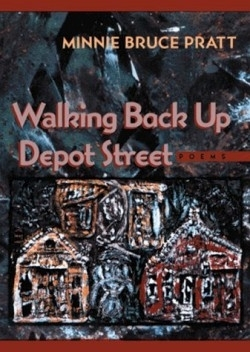
Walking Back Up Depot Street
Enthusiasm for this collection stems as much from the manner in which these poems are structured as from their subject matter. In Minnie Bruce Pratt’s Walking Back Up Depot Street we meet one of the most perceptive characters to populate contemporary poetry, a woman named simply Beatrice who acts both as initiator and vehicle in these moving poems. The landscapes and narratives of the poems—ranging from the domestic and imagistic to profoundly political—are seen through her eyes, a southern woman who, as she learns the history of her own nation’s atrocities toward people of color—primarily black Americans—also struggles with how she must live her life in the face of such knowledge. As a result, the poems never seem preachy or self-righteous. Rather, because readers see them through Beatrice’s eyes, her growing commitment to humanity, and more importantly, to understanding the forces of fear that shape her existence are appreciated.
Though many of the poems stand alone, they are best read as a series, and in that sense are rich with narrative suspense. Because Pratt, however, lets readers see several levels of each incident through Beatrice’s eyes, the poems, despite their historical sources, take on a lyric quality. Seen are her reactions as she traces the journey of a slave who survived the Middle Crossing, as she hears and responds to the voices of sharecropper wives, as she feels the shock of the murders of activists in the Civil Rights movement. Thus, the poems become experimental.
But this is not a collection narrowed by a single stance. As the volume moves into its final sections, Pratt’s heroine touches history throughout the hemisphere, in many languages and in remote places. She scrutinizes sixteenth century Bolivian mines as well as the coal mines of twentieth century Alabama. The connection is poverty, inequality and injustice—no matter the times, people or gender. And always the poems return to Beatrice and what she must do with every new degree of knowing.
This is an exceptional collection in every way: broad in subject, skilled in craft, diverse in its population and conscious of the tragic world. It could be overwhelming and general, but because readers see it through the eyes of Beatrice, readers come to care for her and her vision. In that sense, Pratt has created a Beatrice as momentous as Dante’s. Her Beatrice has not turned away from, but embraced, as clear-eyed as she can, that harsh history which includes everyone. Because of that readers will walk with her into hell—even into our own roles in the story. (April).
Reviewed by
Anne-Marie Oomen
Disclosure: This article is not an endorsement, but a review. The publisher of this book provided free copies of the book to have their book reviewed by a professional reviewer. No fee was paid by the publisher for this review. Foreword Reviews only recommends books that we love. Foreword Magazine, Inc. is disclosing this in accordance with the Federal Trade Commission’s 16 CFR, Part 255.
